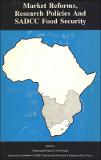| dc.contributor.author | Eicher, Carl K. | |
| dc.coverage.spatial | Southern Africa. | en |
| dc.date.accessioned | 2016-04-19T13:52:03Z | |
| dc.date.available | 2016-04-19T13:52:03Z | |
| dc.date.issued | 1991 | |
| dc.identifier.citation | Eicher, C.K. (1991) Agricultural research priority-setting in Southern Africa: nutrition and household food security issues. In: Rukuni, M. and Wyckoff, J.B. (eds.) Market reforms, research policies and SADCC food security. Harare: UZ/MSU Food Security Research in Southern Africa Project, pp. 215-241. | en |
| dc.identifier.isbn | 0-7974-1000-7 | |
| dc.identifier.uri | https://opendocs.ids.ac.uk/opendocs/handle/20.500.12413/11289 | |
| dc.description | A research paper on how nutrition and household food security can be incorporated in research programmes of national agricultural research systems (NARS). | en |
| dc.description.abstract | The objective of this chapter is to discuss how nutrition and household food security objectives can be incorporated into the research programmes of national agricultural research systems (NARS). Part II presents an overview of food and agriculture in the SADCC region. Part III examines the role of nutrition in agricultural research in historical perspective. We then review the 27-year research programme to increase the protein content of maize through plant breeding because maize is the staple food in at least half the SADCC nations. Part IV discusses studies of the payoff to investment in agricultural research. Part V reviews four quantitative techniques for setting agricultural research priorities in NARS and regional agricultural research systems. We shall then address the key question: Why are these priority-setting procedures rarely used by agricultural research managers in Africa? Because research managers cannot wait until improved techniques are developed to incorporate household food security into research priority-setting in NARS, there is an urgent need to get on with the challenge of promoting rural diversification in less favorable areas in order to expand rural incomes and economic access to food. Part VI addresses rural diversification, a process that can increase rural incomes and economic access to food. Part VII looks to the future and discusses needed research on nutrition and household food security. | en |
| dc.language.iso | en | en |
| dc.publisher | UZ/MSU Food Security Research in Southern Africa Project, Department of Agricultural Economics and Extension, University of Zimbabwe | en |
| dc.rights.uri | http://creativecommons.org/licenses/by-nc-nd/3.0/ | en |
| dc.subject | Agriculture | en |
| dc.subject | Nutrition | en |
| dc.title | Agricultural research priority-setting in Southern Africa: nutrition and household food security issues | en |
| dc.type | Book chapter | en |
| dc.rights.holder | UZ/MSU Food Security Research in Southern Africa Project | en |


